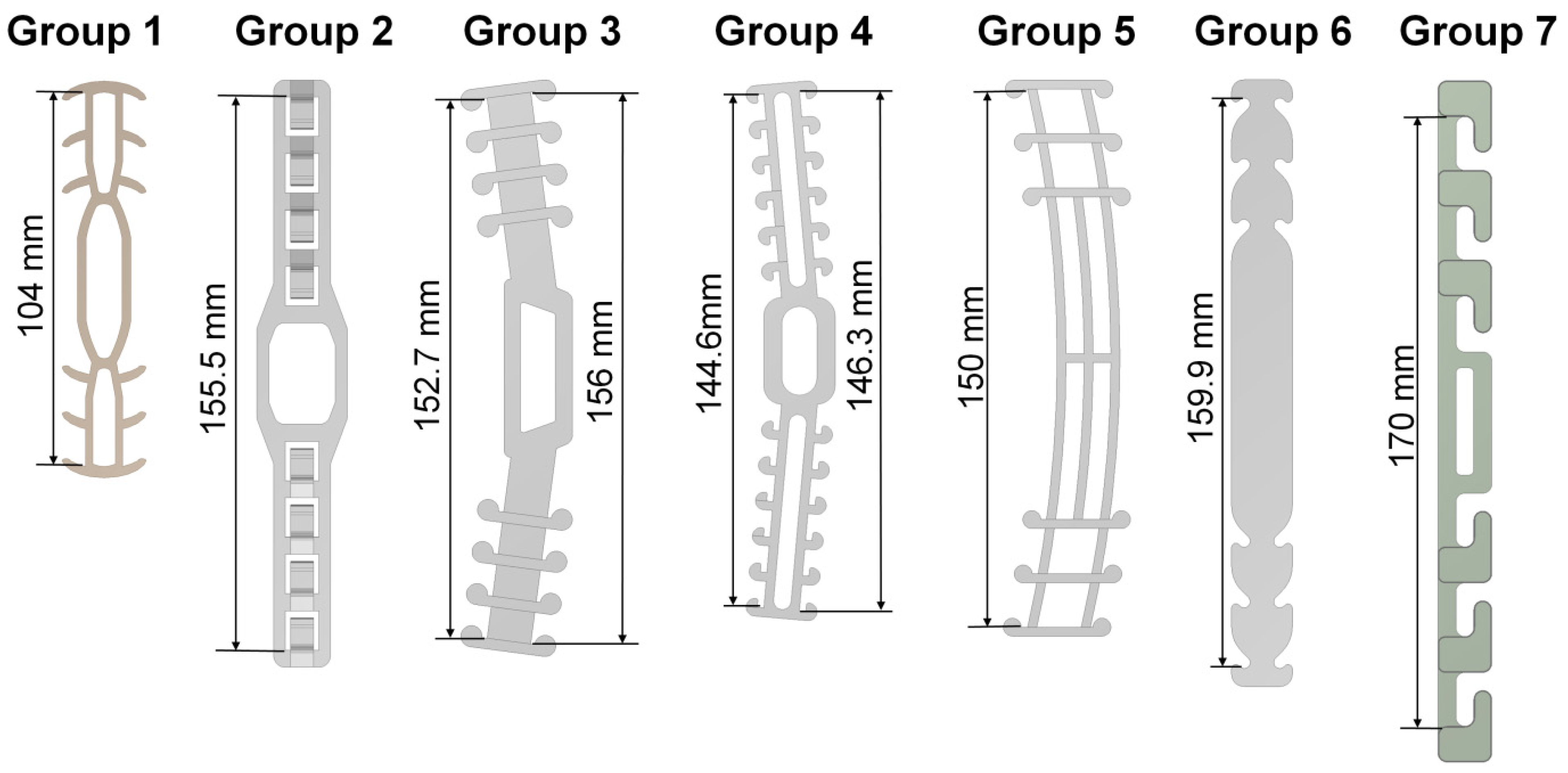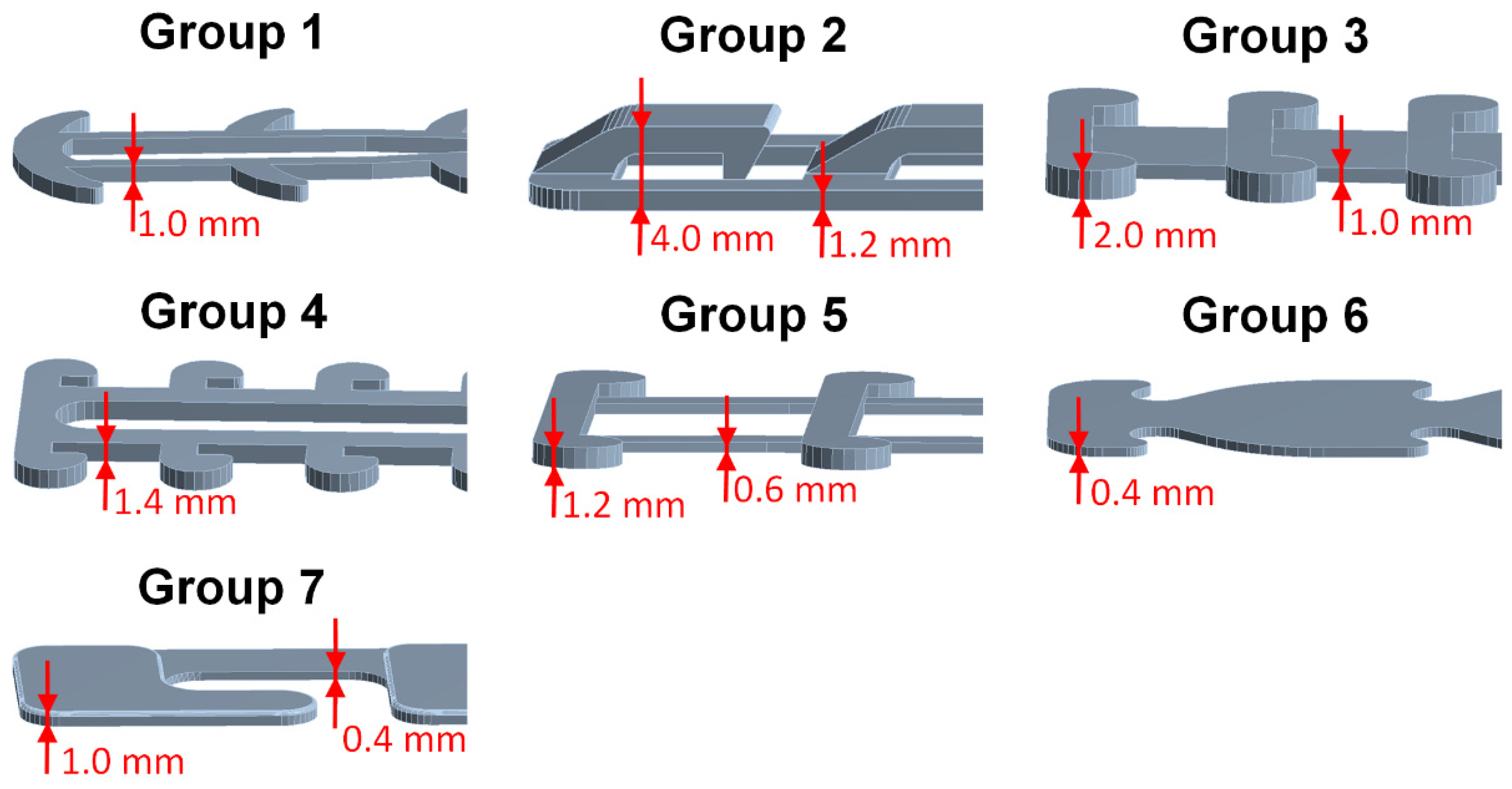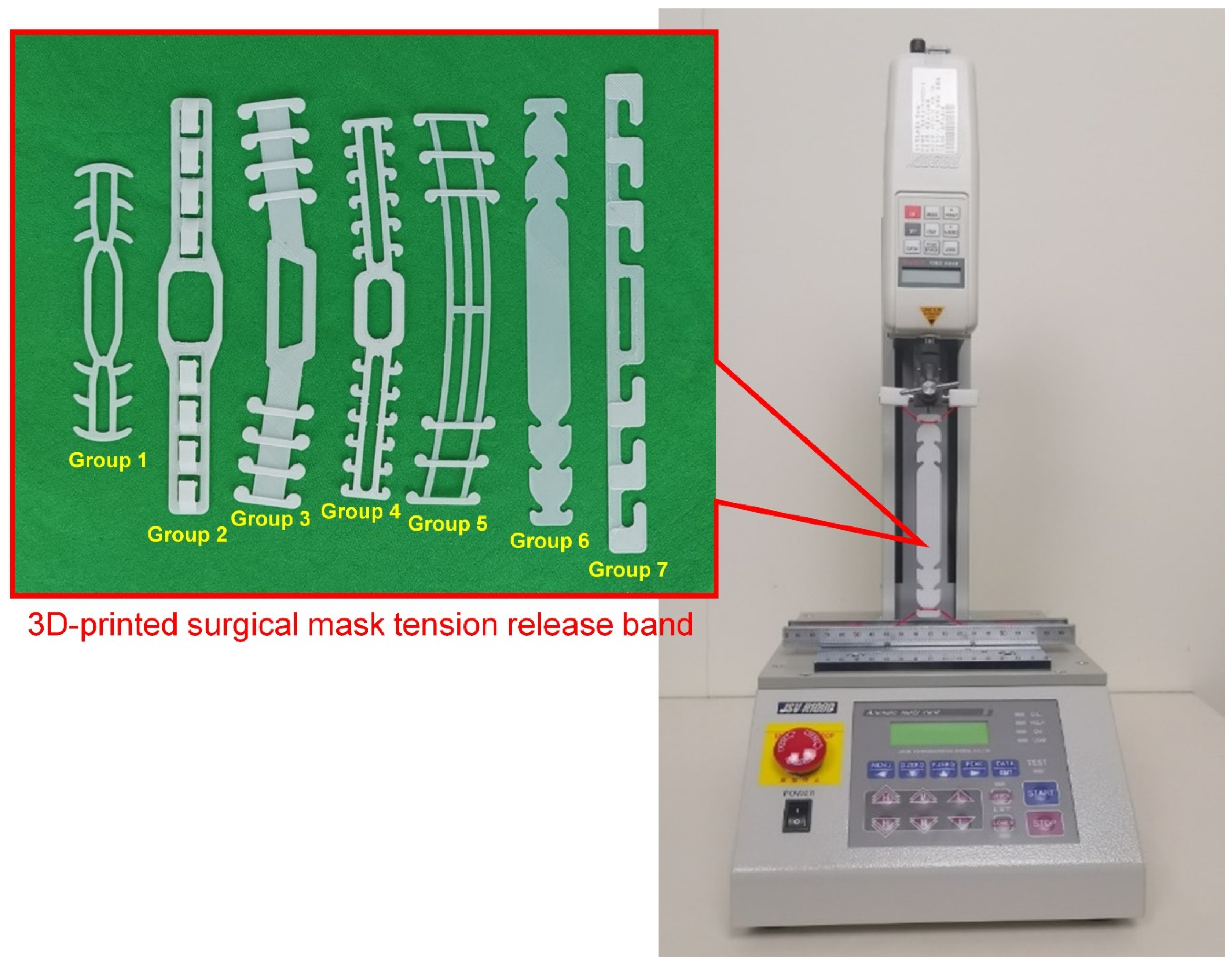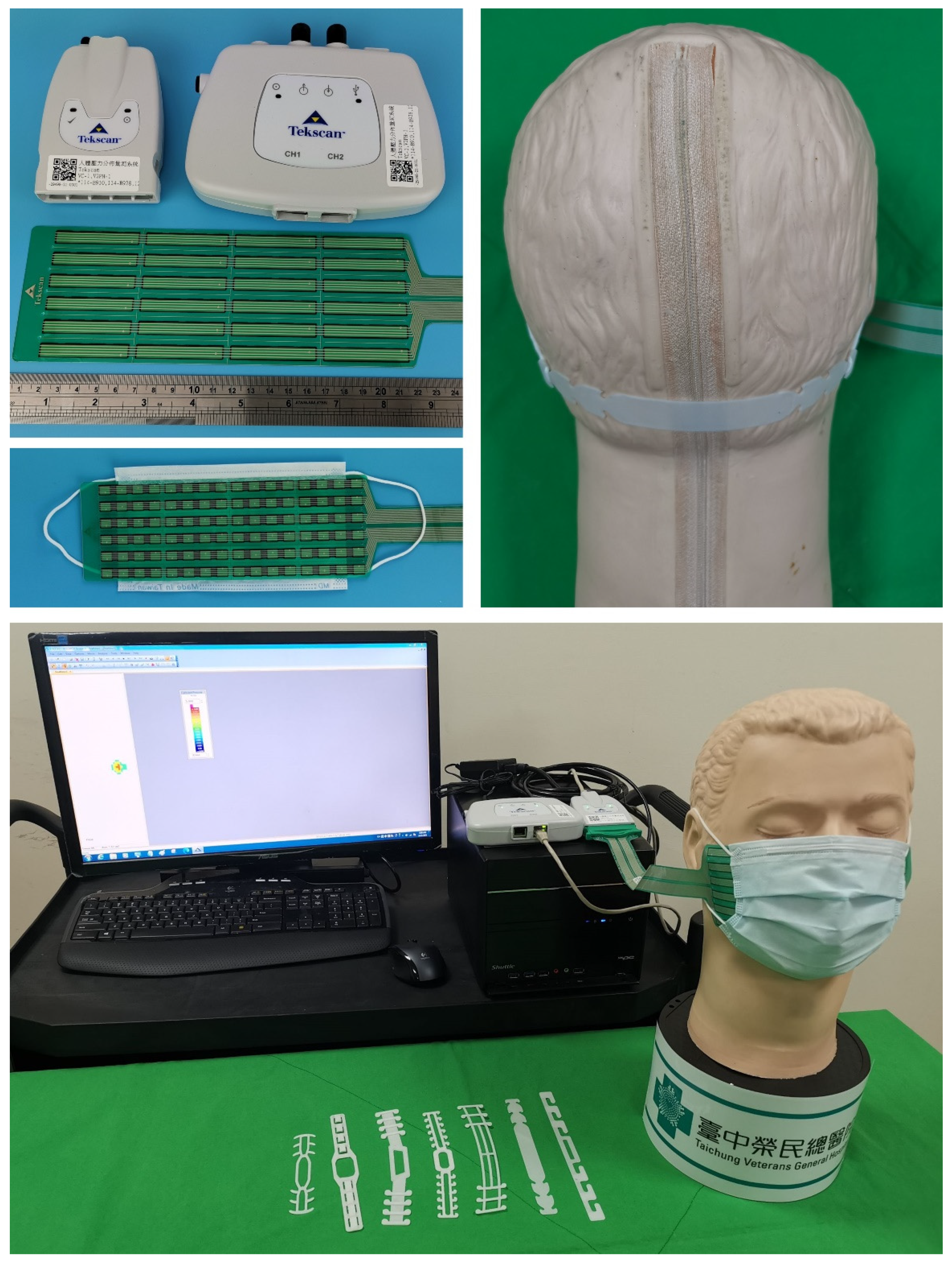Evaluations of 3D-Printed Surgical Mask Tension Release Bands for Common COVID-19 Use with Biomechanics, Sensor Array System, and Finite Element Analysis
Abstract
:1. Introduction
2. Materials and Methods
2.1. SMTRBs of Different Styles
2.2. 3D-Printed SMTRBs
2.3. Stiffness Measurement for the SMTRB Structures
2.4. Measurement of Pressure on the Face by a Sensor Array System
2.5. Finite Element Analysis
3. Results
4. Discussion
5. Conclusions
Author Contributions
Funding
Institutional Review Board Statement
Informed Consent Statement
Data Availability Statement
Acknowledgments
Conflicts of Interest
References
- Coronavirus Disease (COVID-19) Pandemic. Available online: https://www.who.int/emergencies/diseases/novel-coronavirus-2019 (accessed on 29 July 2022).
- Morawska, L.; Cao, J. Airborne transmission of SARS-CoV-2: The world should face the reality. Environ. Int. 2020, 139, 105730. [Google Scholar] [CrossRef] [PubMed]
- Asadi, S.; Bouvier, N.; Wexler, A.S.; Ristenpart, W.D. The coronavirus pandemic and aerosols: Does COVID-19 transmit via expiratory particles? Aerosol Sci. Technol. 2020, 54, 635–638. [Google Scholar] [CrossRef] [PubMed] [Green Version]
- Morawska, L.; Milton, D.K. It is time to address airborne transmission of coronavirus disease 2019 (COVID-19). Clin. Infect. Dis. 2020, 71, 2311–2313. [Google Scholar] [CrossRef] [PubMed]
- Mittal, R.; Meneveau, C.; Wu, W. A mathematical framework for estimating risk of airborne transmission of COVID-19 with application to face mask use and social distancing. Phys. Fluids 2020, 32, 101903. [Google Scholar] [CrossRef] [PubMed]
- Yang, Y.; Shang, W.; Rao, X. Facing the COVID-19 outbreak: What should we know and what could we do? J. Med. Virol. 2020, 92, 536–537. [Google Scholar] [CrossRef] [PubMed] [Green Version]
- Tso, R.V.; Cowling, B.J. Importance of face masks for COVID-19: A call for effective public education. Clin. Infect. Dis. 2020, 71, 2195–2198. [Google Scholar] [CrossRef]
- Zuo, Y.; Hua, W.; Luo, Y.; Li, L. Skin reactions of N95 masks and medial masks among health care personnel: A self-report questionnaire survey in China. Contact Dermat. 2020, 83, 145–147. [Google Scholar] [CrossRef]
- Shenal, B.V.; Radonovich, L.J., Jr.; Cheng, J.; Hodgson, M.; Bender, B.S. Discomfort and exertion associated with prolonged wear of respiratory protection in a health care setting. J. Occup. Environ. Hyg. 2012, 9, 59–64. [Google Scholar] [CrossRef]
- Ravi, P.; Antoline, S.; Rybicki, F.J. 3D printing of open-source respirators (including N95 respirators), surgical masks, and community mask designs to address COVID-19 shortages. In 3D Printing in Medicine and Its Role in the COVID-19 Pandemic: Personal Protective Equipment (PPE) and Other Novel Medical and Non-Medical Devices; Rybicki, F.J., Ed.; Springer International Publishing: Cham, Switzerland, 2021; pp. 91–106. [Google Scholar]
- Ravi, P.; Lawera, N.; Rybicki, F.J. Literature and Media-Based Review of Personal Protective Equipment 3D Printing Efforts During COVID-19. In 3D Printing in Medicine and Its Role in the COVID-19 Pandemic; Rybicki, F.J., Ed.; Springer International Publishing: Cham, Switzerland, 2021; pp. 3–16. [Google Scholar]
- Manero, A.; Smith, P.; Koontz, A.; Dombrowski, M.; Sparkman, J.; Courbin, D.; Chi, A. Leveraging 3D printing capacity in times of crisis: Recommendations for COVID-19 distributed manufacturing for medical equipment rapid response. Int. J. Environ. Res. Public Health 2020, 17, 4634. [Google Scholar] [CrossRef] [PubMed]
- Choong, Y.Y.C.; Tan, H.W.; Patel, D.C.; Choong, W.T.N.; Chen, C.-H.; Low, H.Y.; Tan, M.J.; Patel, C.D.; Chua, C.K. The global rise of 3D printing during the COVID-19 pandemic. Nat. Rev. Mater. 2020, 5, 637–639. [Google Scholar] [CrossRef] [PubMed]
- Longhitano, G.A.; Nunes, G.B.; Candido, G.; da Silva, J.V.L. The role of 3D printing during COVID-19 pandemic: A review. Prog. Addit. Manuf. 2021, 6, 19–37. [Google Scholar] [CrossRef]
- Aydin, A.; Demirtas, Z.; Ok, M.; Erkus, H.; Cebi, G.; Uysal, E.; Gunduz, O.; Ustundag, C.B. 3D printing in the battle against COVID-19. Emerg. Mater. 2021, 4, 363–386. [Google Scholar] [CrossRef] [PubMed]
- NIH 3D Print Exchange Home Page. Available online: https://3dprint.nih.gov (accessed on 29 July 2022).
- O’Connor, Z.; Huellewig, D.; Sithiyopasakul, P.; Morris, J.A.; Gan, C.; Ballard, D.H. 3D printed mask extenders as a supplement to isolation masks to relieve posterior auricular discomfort: An innovative 3D printing response to the COVID-19 pandemic. 3D Print. Med. 2020, 6, 1–5. [Google Scholar] [CrossRef] [PubMed]
- Varanges, V.; Caglar, B.; Lebaupin, Y.; Batt, T.; He, W.; Wang, J.; Rossi, R.M.; Richner, G.; Delaloye, J.-R.; Michaud, V. On the durability of surgical masks after simulated handling and wear. Sci. Rep. 2022, 12, 1–10. [Google Scholar] [CrossRef] [PubMed]
- Papadopoulos, E.; Nikolopoulos, C.; Athanasopoulos, S. The effect of different skin–ankle brace application pressures with and without shoes on single-limb balance, electromyographic activation onset and peroneal reaction time of lower limb muscles. Foot 2008, 18, 228–236. [Google Scholar] [CrossRef] [PubMed]
- Driscoll, M. The impact of the finite element method on medical device design. J. Med. Biol. Eng. 2019, 39, 171–172. [Google Scholar] [CrossRef] [Green Version]
- Kiendl, J.; Gao, C. Controlling toughness and strength of FDM 3D-printed PLA components through the raster layup. Compos. Part B Eng. 2020, 180, 107562. [Google Scholar] [CrossRef]
- GB 19083-2010: PDF in English. Available online: https://www.chinesestandard.net/PDF.aspx/GB19083-2010 (accessed on 29 July 2022).
- Żur, P.; Kołodziej, A.; Baier, A. Finite elements analysis of pla 3d-printed elements and shape optimization. Eur. J. Eng. Sci. Technol. 2019, 2, 59–64. [Google Scholar] [CrossRef] [Green Version]
- Wang, T.-K.; Solano, T.; Shoele, K. Bridge the gap: Correlate face mask leakage and facial features with 3D morphable face models. J. Expo. Sci. Environ. Epidemiol. 2021, 5, 1–9. [Google Scholar] [CrossRef] [PubMed]







| SMTRB Information (Data Accessed on 29 July 2022) | ||
|---|---|---|
| Group 1 | File name | Ear Savers for Health Workers |
| File website | https://3dprint.nih.gov/discover/3dpx-013860 | |
| Thickness | 1.0 mm | |
| Group 2 | File name | Surgical Mask Band for Ear Comfort—Extra Security V2 |
| File website | https://3dprint.nih.gov/discover/3dpx-013574 | |
| Thickness | 1.2 mm–4.0 mm | |
| Group 3 | File name | Surgical Mask Tension Release Band for Ear Comfort and Extended Use |
| File website | https://3dprint.nih.gov/discover/3dpx-013410 | |
| Thickness | 1.0 mm–2.0 mm | |
| Group 4 | File name | Surgical Mask Tension Release Band STRISSE |
| File website | https://3dprint.nih.gov/discover/3dpx-013615 | |
| Thickness | 1.4 mm | |
| Group 5 | File name | Ear Saver for Surgical Mask |
| File website | https://3dprint.nih.gov/discover/3dpx-013675 | |
| Thickness | 0.6 mm–1.2 mm | |
| Group 6 | File name | Disposable Ear Relief Strap |
| File website | https://3dprint.nih.gov/discover/3DPX-013564 | |
| Thickness | 0.4 mm | |
| Group 7 | File name | Flexible Mask Hook (Simple) |
| File website | https://3dprint.nih.gov/discover/3dpx-013752 | |
| Thickness | 0.4 mm–1.0 mm | |
| Group 1 | Group 2 | Group 3 | Group 4 | Group 5 | Group 6 | Group 7 | |
|---|---|---|---|---|---|---|---|
| Printing Time (min) | 7 | 35 | 31 | 21 | 13 | 13 | 15 |
| The Weight of the PLA (g) | 1 | 4 | 4 | 3 | 2 | 2 | 2 |
| The Length of the PLA (m) | 0.12 | 0.49 | 0.49 | 0.3 | 0.19 | 0.23 | 0.25 |
| Mesh | Group 1 | Group 2 | Group 3 | Group 4 | Group 5 | Group 6 | Group 7 |
|---|---|---|---|---|---|---|---|
| Number of Nodes | 29,469 | 77,388 | 69,230 | 58,450 | 45,118 | 58,341 | 79,394 |
| Number of Elements | 14,566 | 41,403 | 35,567 | 29,091 | 21,732 | 28,345 | 41,328 |
| Observed Index | Group 1 | Group 2 | Group 3 | Group 4 | Group 5 | Group 6 | Group 7 | Without SMTRB | |
|---|---|---|---|---|---|---|---|---|---|
| Maximum Break Force (kgf) | Max | 4.840 | 6.540 | 17.890 | 8.780 | 7.740 | 3.650 | 2.120 | - |
| Mean | 3.687 | 5.322 | 14.379 | 7.832 | 5.247 | 2.828 | 1.756 | - | |
| SD | 0.854 | 0.606 | 2.248 | 0.661 | 1.080 | 0.452 | 0.287 | - | |
| Tensile Displacement (mm) | Max | 11.060 | 13.530 | 33.190 | 19.300 | 17.520 | 7.350 | 7.400 | - |
| Mean | 9.613 | 10.617 | 26.503 | 15.367 | 11.943 | 6.304 | 5.242 | - | |
| SD | 1.157 | 1.493 | 5.264 | 1.607 | 2.449 | 0.724 | 0.807 | - | |
| Stiffness (kgf/mm) | Max | 0.546 | 0.647 | 0.751 | 0.723 | 0.590 | 0.588 | 0.427 | - |
| Mean | 0.448 | 0.588 | 0.616 | 0.614 | 0.507 | 0.532 | 0.387 | - | |
| SD | 0.077 | 0.035 | 0.074 | 0.086 | 0.046 | 0.051 | 0.039 | - | |
| Pressure (N/cm2) | Max | 6.090 | 1.880 | 3.648 | 1.543 | 2.518 | 1.543 | 0.990 | 0.726 |
| Mean | 4.917 | 1.556 | 3.130 | 2.662 | 2.097 | 1.300 | 0.901 | 0.515 | |
| SD | 0.639 | 0.258 | 0.305 | 0.478 | 0.224 | 0.171 | 0.070 | 0.147 |
| Group | Advantages | Disadvantages |
|---|---|---|
| Group 1 | The shortest 3D printing time and the saving of 3D printing material. | Greater pressure on the face when wearing. |
| Group 2 | The hook structure design prevents the ear loops from falling off. | Longer 3D printing time. Higher cost of 3D printing material. Fragile hook design. |
| Group 3 | Stronger structural strength. | Longer 3D printing time. Higher cost of 3D printing material. Greater pressure on the face. |
| Group 4 | Stronger structural strength and bending ability. | The hook is too small to hold. |
| Group 5 | Relatively shorter 3D printing time and lower cost of material. | The stress value of the hook position is large and easy to break. |
| Group 6 | Relatively shorter 3D printing time. Lower cost of 3D printing material. Structural design is not easy to damage. | The ear loops slip off easily when the mask is hooked. |
| Group 7 | Relatively shorter 3D printing time. Lower cost of 3D printing material. Structural design is not easy to damage. | The ear loops slip off easily when the mask is hooked. |
Publisher’s Note: MDPI stays neutral with regard to jurisdictional claims in published maps and institutional affiliations. |
© 2022 by the authors. Licensee MDPI, Basel, Switzerland. This article is an open access article distributed under the terms and conditions of the Creative Commons Attribution (CC BY) license (https://creativecommons.org/licenses/by/4.0/).
Share and Cite
Su, K.-C.; Wang, C.-H.; Yen, Y.-C. Evaluations of 3D-Printed Surgical Mask Tension Release Bands for Common COVID-19 Use with Biomechanics, Sensor Array System, and Finite Element Analysis. Sensors 2022, 22, 5897. https://doi.org/10.3390/s22155897
Su K-C, Wang C-H, Yen Y-C. Evaluations of 3D-Printed Surgical Mask Tension Release Bands for Common COVID-19 Use with Biomechanics, Sensor Array System, and Finite Element Analysis. Sensors. 2022; 22(15):5897. https://doi.org/10.3390/s22155897
Chicago/Turabian StyleSu, Kuo-Chih, Chun-Hsiang Wang, and Yu-Chun Yen. 2022. "Evaluations of 3D-Printed Surgical Mask Tension Release Bands for Common COVID-19 Use with Biomechanics, Sensor Array System, and Finite Element Analysis" Sensors 22, no. 15: 5897. https://doi.org/10.3390/s22155897







